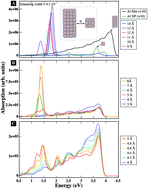An asymmetric aluminum active quantum plasmonic device†
Abstract
Plasmonic metal nanostructures support intense nanoscale electromagnetic hotspots that can be modulated in an active plasmonic device. Electrical manipulation is a reversible route to manipulate plasmon resonances in sub-nanoscale distances because a bias voltage can modify the electron tunneling barrier. In this manuscript, we use time-dependent density functional theory (TDDFT) to examine the impact of quantum effects on an asymmetric nanoparticle dimer composed of an aluminum (Al) nanoparticle on a much larger Al rectangular cuboid. This asymmetric system is intended to model some of the effects of a metal nanoparticle coupling to a metal film which is a prototypical plasmonic antenna structure. As the distance between the asymmetric dimer shrinks, the dipolar gap plasmon (DGP) redshifts and a charge transfer plasmon (CTP) appears that is influenced by optically-induced conductance in the nanoscale junction. The relatively high optical conductivity of Al enables a smooth transition from capacitive to conductive coupling, allowing us to find the DGP–CTP crossover distance (d ∼ 6 Å). Surprisingly, a closer evaluation of crossover plasmon resonance revealed two separate peaks with near-field distributions that match the CTP and anti-bonding mode of the gap plasmon. Applying an electrical bias to this crossover system modifies the effective conductance of the tunneling barrier, making it possible to reversibly tune the wavelength of the plasmon modes. This work demonstrates how asymmetry becomes a key feature in active plasmonic devices using electrical bias, because asymmetry enables the use of positive and negative biases to tune the system over a broader range of wavelengths.



 Please wait while we load your content...
Please wait while we load your content...